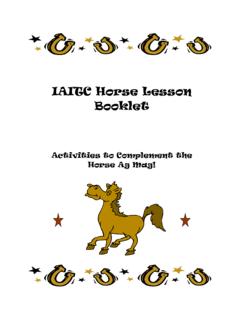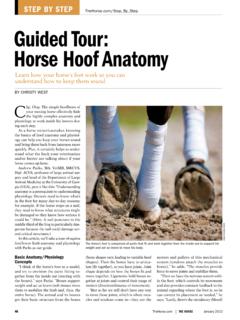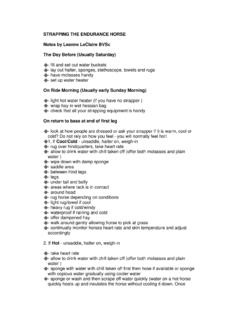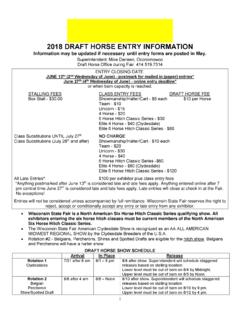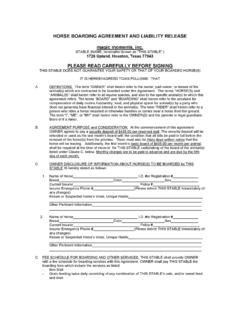Transcription of Indiana 4-H Horse and Pony Handbook
1 Indiana 4-H Horse and pony HandbookTwelfth Edition, 1/11 This Handbook is the property of: Name _____Address _____County _____ Phone (____)_____Purdue University Cooperative Extension Service, West Lafayette, Indiana4-H-661-W Table of Contents4-H Mission, Objectives, Goals, Rules and Policies .. 4 Animal s Age and 4-H Member s Grade .. 5 Ownership .. 5 Approved Protective Attire .. 5 Show Guidelines .. 6 Non-Protestable Decisions .. 7 State Show Eligibility Requirements .. 7 Drug Testing .. 7 Measurement Procedures .. 7 Halter .. 9 Showmanship at Halter ..10 Hunter Type Tack and Attire ..11 Hunter Hack ..12 Hunter Over Fences ..13 Hunt Seat Equitation on the Flat ..15 Hunt Seat Equitation Over Fences ..16 Hunter Under Saddle ..17 Jumper ..18 English Saddle Type Tack and Attire ..19 Saddle Seat Equitation.
2 20 Saddle Seat Pleasure ..21 Gaited English Pleasure ..21 Pleasure Driving ..22 Western Tack and Attire ..23 Western Horsemanship (Equitation) ..25 Western Pleasure ..27 Gaited Western Pleasure ..27 Western Riding ..28 Trail ..30 Reining ..36 Barrel Race ..41 Flag Race ..42 Keyhole Race ..44 Pole Bending ..45 Speed and Action ..46 Dressage ..47 Color Guard..51 Walk-Trot Equitation/Horsemanship ..55 Leadline Equitation/Horsemanship ..56 Glossary ..57 References ..60 Note: Some classes may not be offered at the State 4-H :Colleen BradyReviewers:State 4-H Horse and pony Advisory Committee12th Edition January 2011 Note: Text in italics indicates a change or OF 4-HThe mission of today s 4-H is to help youth and volunteers in their develop-ment through experiential educational programs. It is accomplished through direct involvement of youth, adults, and the objectives of the Indiana 4-H Horse and pony program are:1.
3 To develop leadership, initiative, self-reliance, sportsmanship and other desirable character traits. 2. To develop an appreciation of Horse well-being and proper To experience the pride and the responsibilities of owning a Horse or To learn good horsemanship and an understanding of proper management for breeding, raising and training horses and To provide an opportunity to observe and learn through participation and To accept constructive criticisms and learn new ways of training and caring for To provide an opportunity for educational experiences through county, area and state Indiana 4-H Horse and pony Handbook is written as a training manual for 4-H ers and 4-H leaders throughout the State of Indiana . In a Horse program as large as Indiana s, consistency is very important for smooth operation of the program.
4 Due to the variations in size and organization of the Horse clubs, counties need the right to adapt or add to these rules to meet local needs. Therefore, the local 4-H educator has the final say in using or changing these rules for local shows. However, when the 4-H er comes to the State 4-H Horse and pony Shows, these rules, as set forth in this manual, will be strictly fol-lowed. Rules governing exhibitor safety (headgear and boots) and animal well-being are mandatory at all 4-H Horse and pony events and activities. PROGRAM POLICIES Please note: Program policies may be updated more frequently than this rulebook. The official Indiana 4-H Program Policies and Procedures supersedes any policies in this First and foremost, all exhibitors, parents and spectators will conduct themselves as ladies and gentlemen. They will be expected to conduct themselves in such a manner as to set a good example for other 4-H exhibitors and other spectators at the show.
5 Inhumane treatment of animals, impolite behavior, poor sportsmanship, or disruptive actions, (as deemed by the show management) will result in disqualification and/or removal from the grounds. 2. It is strongly suggested that these policies and rules be used as a guide in county programs. 3. Safety rules governing headgear and boots, and rules addressing animal well-being, are mandatory at all 4-H Horse and pony events. Judges have the responsibility to refuse to conduct classes in which these safety rules are not The State 4-H Horse and pony Advisory Committee shall be the representative of Indiana s 4-H Horse and pony leaders and members. (Refer to the Advisory Committee Constitution and By-laws for details of the committee structure.)5. Any situation not covered by these policies and rules shall be handled by the proper representative of the Purdue University Cooperative Extension Service, or their of animal and grade of 4-H member 1.
6 Any boy or girl in Indiana who is enrolled in 4-H may participate in 4-H classes and activities, providing he/she meets the eligibility rules for Youth may become 4-H members when they enter the third grade and continue thru grade 12. These individuals may continue their 4-H membership for a maximum of ten (10) years. For summer shows, a child s grade in school is the grade they were in on January 1st of the current year. Children advance one grade/year of 4-H involvement, regardless of academic 4-H Junior and Senior categories: Juniors 3rd 7th grade Seniors 8th grade and above4. The age of an animal will be computed on the basis of a calendar year starting on January 1 of the year foaled. For example, an animal foaled any time in 1998 would be considered one year old (a yearling) on January 1, 1999, two years old on January 1, 2000, etc.
7 Animals five years of age and younger will be considered junior It is recommended that horses not be ridden in 4-H events before July 1 of their two year old Exhibitor must be enrolled during the current year in the 4-H project exhibited. 2. Animal must be under the 4-H member s ownership or lease by May 15 and this ownership must be maintained continuously until the completion of the State Fair. Records must be started by May 15. Absolutely no animal may be substituted or traded for the original animal after May 15. 3. 4-H animals exhibited after the animal enrollment deadline (April 1st for steers and May 15th for all other animals), under a different name than the person listed on the Indiana 4-H animal enrollment form shall not be eligible to be shown in the 4-H show at the Indiana State Fair. This means that if the animal is exhibited at any show by anyone other than a person listed on the Indiana 4-H enrollment form, the animal will not be eligible to be shown in the 4-H show at the Indiana State Fair.
8 This term/condition does not apply to siblings, who may show each other s animals at any show during the year without jeopardizing State Fair eligibility, regardless of whether or not the sibling is a 4-H member. 4-H animals are expected to be in the possession and regular care of the 4-H member who owns/leases them (unless other arrangements have been agreed upon by the county 4-H council) from the animal enrollment deadline until the conclusion of the county and/or state fair. NOTE: This term/condition does not apply to the Horse & pony program where a parent MAY also show the Horse or pony after it has been enrolled in the 4-H Leasing is considered the equivalent of ownership of a 4-H project ani-mal. The 4-H er should be regularly involved in the care of the Horse , regardless of where stabled, and the 4-H er should have exclusive show use of the animal during the 4-H lease Protective Attire:Headgear: All 4-H members are required to wear a properly fitted ASTM or SEI standard F1163 (or above) certified equestrian helmet whenever mounted, or driving, at a 4-H Horse and pony event, show, or activity.
9 The 4-H member is responsible to see that this specified headgear is properly fitted with the approved harness fastened in place whenever mounted. Original tags must be present in all approved helmets. This policy applies to all county, area, and state 4-H Horse and pony events, shows, and : Protective vests are recommended in all mounted Guidelines 1. First and foremost, all exhibitors, parents and spectators will conduct themselves as ladies and gentlemen. They are expected to conduct themselves in such a manner as to set a good example for other 4-H exhibitors and other spectators at the show. Inhumane treatment of animals,impolite behavior, poor sportsmanship, or disruptive actions, (as deemed by the show management) will result in disqualification and/or removal from the grounds. 2. All animals must be sound, humanely treated and healthy.
10 (Refer to Extension Publications AS-552, AS-554, and ID-269 for guidelines). Animals are subject to inspection by a licensed veterinarian and questionable animals may be Animals under 40 in height shall not be ridden at 4-H events. It is recommended that the weight of the rider does not exceed 30% of the weight of the Only 4-H Horse and pony members may ride or drive 4-H animals on the 4-H show grounds. 5. All 4-H riders in the 4-H show must wear the proper footwear of western, hunt or jodhpur boots. Drivers must wear boots or closed shoes. 6. Stallions are not eligible to show, except during the calendar year they are foaled. 7. Weanlings, yearlings and two-year-old animals must be shown at the height of the dam, unless their height exceeds that of the dam. If the dam s height is unknown, the animal will show in the over 56 inches class.

